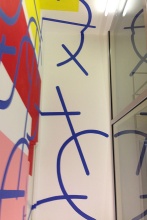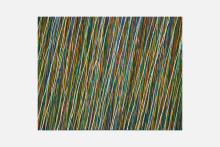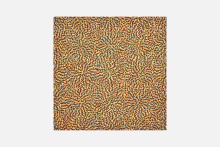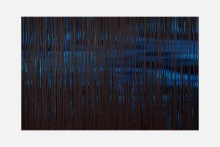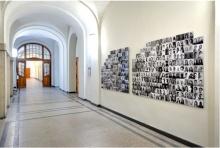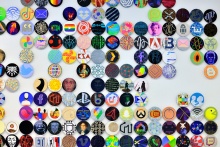Date added: 2022-10-05
Art is my point of reference
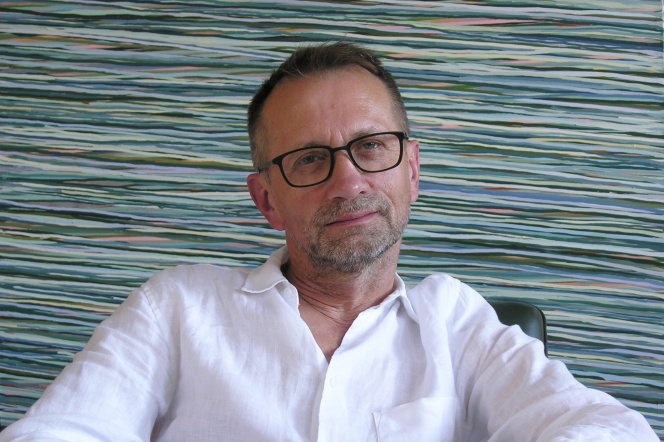
Barbara Kuklińska: What is it like for an artist to work among engineers and scientists in the field of exact sciences?
Jan Buczkowski: I started working at the University of Technology a year after graduating from art studies, and right after completing a year of military service. When I entered the Main Building for the first time in the fall of 1987, I was shocked. Accustomed to the not too large and austere interiors of my previous university, I felt as if I had entered a different world. The vastness of historical spaces was overwhelming for me and reminded me more of a palace than a place where students are taught. It turned out, however, that on the top of the building, right under the then non-existent tower, there is a place that resembles the interior of an artistic school - these are the painting studios of the Department of Drawing, Painting and Sculpture (now the Department of Visual Arts) of the Faculty of Architecture. Soon, when I started working, it turned out that "I grabbed God by the feet." I found a team of wonderful people (professors Zdzisław Brodowicz, Jan Góra and Aniela Kita) who created a friendly atmosphere. They accepted me as a friend. I was given a lot of freedom - I was allowed to pursue my artistic and didactic ideas - I felt as if I was a professor, not an assistant. With time, I also got to know people from other departments and faculties - architects, engineers, researchers - who deal with something different on a daily basis, look at the world differently, and even use a slightly different language. I realized that the addressees of my art are also among them. I understood that this mixture of interests, meeting people from different fields in one place, can be inspiring. It greatly enriches and develops me, allows me to carry out various projects, teaches me to distance myself and treat the surrounding with humility. For me, art is still a reference point for everything I do, a way of life, something that has always interested me the most. And it will probably never change. I transfer my experience in creative work to my teaching. Because only then are artistic problems, problems of creating art, credible when they are supported by my own artistic experience.
Let's reverse the situation - do engineers need art?
Art concerns both the perceived and experienced world, and its introduction into the human environment must be a continuous process. Regular and thoughtful contact with various forms of art, regardless of the degree of artistic abilities, develops our creativity, opens us to new ways of thinking and seeing the world. Art knocks us out of certainty, established truths and triggers creative anxiety. It seems obvious that the engineer of the future, in order to be able to meet new challenges, should be equipped with skills that go beyond a narrow range of specializations. A humanist engineer, a man open to the changing reality, is a much better employee, more creative and open to the world than a technocrat locked in his or her narrow specialty. Contact with art allows us to build and develop our individual features and interests, and to shape a sense of criticism, which may translate into the ability to flexibly adapt to a rapidly changing reality.
Nałęczów, where you studied in high school, and Gdańsk are more than 500 kilometers away. Why did you choose this city to study, and then to live and work?
I've always wanted to be a painter. When I finished art school in Nałęczów, I planned to study art in Warsaw, but certain formal requirements prevented me from taking the entrance exam at the Warsaw Academy of Fine Arts. A classmate persuaded me to apply to Gdańsk together. I managed to get admitted. For 5 years I studied painting at the State Higher School of Fine Arts (now the Academy of Fine Arts), and then, through a competition in 1988, I was employed at Gdańsk University of Technology. I liked it and I stayed in Gdańsk, and my friend returned to Nałęczów.
The Visual Identification System that you introduced to the university is a multi-stage and time-consuming project.
Looking at it now, if I had been aware of the time, energy, and mental toughness it requires, I would not have taken up this task. Luckily, at the very beginning I didn't realize that. The first, as it soon turned out, the most difficult element of the whole process was the design of the new logotype. The change was inspired by the rector prof. Henryk Krawczyk, who decided that the current logo was illegible and not very recognizable. At that time, Gdańsk University of Technology, despite promoting and introducing European standards of higher education, was burdened with the image of the university "from years before". The project prepared by the Mamastudio studio in Warsaw is a modern interpretation of the historical convention of the coat of arms. It uses well-known and recognizable symbolic and allegorical motifs, associated for centuries with the identification of Gdańsk. The natural combination of the symbolism of the place and the university determines the complementary structure of the sign, reflecting the symbiosis in which the city and the university live. Despite the initial wave of criticism, the logo was approved by the Gdańsk Tech Senate. It was just the beginning of changes and work related to building a coherent system of visual identification. First, it was necessary to take care of its basic elements, such as: banner, flag, diploma designs, letter templates, stationery, external and internal signage of buildings and many, many more. Then there were other steps, such as Gdańsk Tech Sport logotype, the dynamic form of which directly refers to the basic symbol, has become an element of sports outfits of players, the decor of sports halls as well as advertising and information materials about sports at the university.
The next step was to change the faculty logos?
Yes. It was also a difficult task as each faculty was very attached to its symbol. The problem was they were all different in style, there was no consistency. After the change, which was associated with many discussions, it was possible to maintain the separateness of "small homelands" - logotypes adequately characterize each of the faculties, show its specificity, and at the same time create a graphically coherent whole.
The new visual version of the university gained publicity and recognition.
Yes. The logotype of Gdańsk University of Technology and visual identification, although initially received quite coldly among the academic community, quickly gained recognition outside. The Visual Identification System received the second prize in the world competition Best Brand Awards Europe & Russia, and the new logo was recognized as the best rebranding of 2013 in Poland. Until today, the industry portal Behance receives only enthusiastic comments from around the world. It was reading them that greatly helped me get through the difficult times of the initial changes. The constant appreciation from various sides is tangible proof that we have chosen the right direction for change.
The VIS, however, is not the end of changes. You also coordinated the introduction of the new university website.
We are just completing this three-year-long process, which has also been and continues to be quite a challenge. The implementation of a new website that would take into account the needs of external and internal recipients, which would have a modern interface and be intuitive in searching for information, required a lot of time and the involvement of a large group of employees. I think we succeeded. The website is simple, clear and easy to read. The graphic design was also prepared by Mamastudio, and the transfer of a huge amount of content from the old unit sites to the new content management system is only now coming to an end. On the other hand, modifying the website is a never-ending process that requires cooperation with a large number of editors. In order to adapt to the changing needs of recipients and the latest trends, constant adjustments are necessary. We are getting signals that our website is a point of reference for other universities in Poland that have undertaken to rebuild their image. It is a stimulus for us not to succumb to the temptation of complacency and to constantly develop.
In addition to the whole identification system, you also try to enliven the campus space with art.
Together with a team of artists from the Department of Visual Arts, we introduce contemporary elements of art to the historic interior of the Main Building and other spaces of the campus. I will start with the courtyards of Fahrenheit and Hevelius, where images of patrons appeared after revitalization. Works using the modern language of art and using modern technologies fit very well into the historical places. In the space of the Main Building there are also works that we realized during the classes together with students: sculptures and spatial objects, which can be admired in front of the library and the Senate Hall. There is "Antimask" - two photographic works, a kind of record of emotions during the first waves of the COVID-19 pandemic and confinement at home. We also carry out painting projects with students; an example is the staircase at level 400, spaces in the elevator shaft or student compositions on the walls of the corridors adjacent to the Senate Room. The building, designed years ago by Albert Carsten, with high-class sculptural elements on the facades, is perfect for adding new elements of art characteristic to contemporary generations, in line with the principle "Every epoch has its art".
Let's walk around the campus, what can we see there?
It is worth mentioning the recently completed mural behind the building of the Faculty of Electronics, Telecommunications and Informatics and two works that decorate the hall of the FETI building. It is a large-format painting "Elektron" by prof. Krzysztof Wróblewski, and this year's monumental painting installation "The Game", which we created together with Dominika Krechowicz, PhD, DSc, Art, professor at Gdańsk Tech, Edyta Urwanowicz, PhD, Art, and prof. Krzysztof Wróblewski.
You have also started the process of creating an unusual museum on the campus.
This idea, which has been around for many years, was born in collaboration with prof. Lucyna Nyka and currently operates under the working name of a museum of art and technology, where apart from art objects, interesting technical objects are also exhibited. In the Hydromechanics building, courtesy of the National Maritime Museum, we have exhibited unique kayaks, and in the university park, a prototype rescue capsule designed by prof. Jerzy Doerffer and Lech Rowiński, PhD is currently being installed. In its vicinity there will be, among others mooring poles, bearings from the Gen. Grot-Rowecki’s bridge, as well as sculptures by Janusz Tkaczuk, which are part of the collection to be acquired in the near future. We will mix and match objects of art and technology, in various, often non-obvious places on the campus, so that they can be accessible not only to the academic community, but also to our guests.
What are your professional plans for the near future?
I will be working on my artistic projects and taking part in exhibitions. Together with the Promotion Office team, we will prepare new projects to promote the university. I would also like to develop a museum of art and technology, start cataloging the objects that will be part of the exhibition. In the last dozen or so years, the university authorities have created conditions for the artists from the Department of Visual Arts to take their ideas and works beyond the studio space, and I hope that we will continue this together in various projects.
And apart from work and art, is there time and space for other passions?
I really appreciate physical activity - I cycle to work, also in winter, I like downhill skiing, until recently I played tennis regularly, but I have a forced break for the time being. Overall, complete relaxation, preferably in an open space, surrounded by nature. Also DIY and garden work in the family home. I am also involved in local projects aimed at restoring green spaces to cities.


